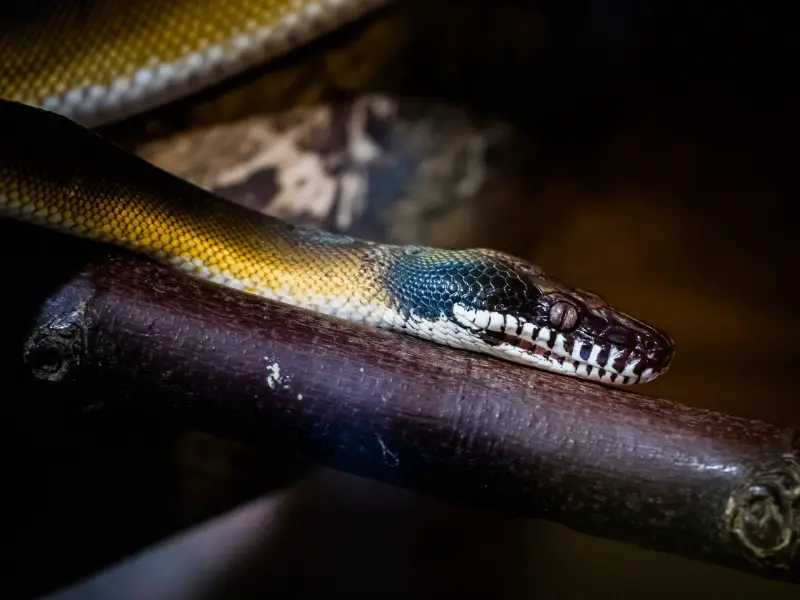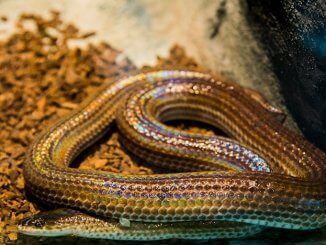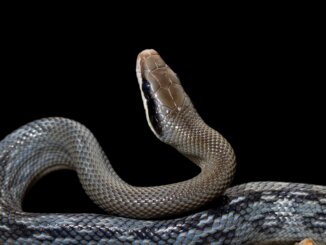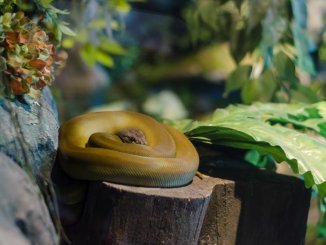The white lipped python is a medium-sized python with iridescent scales, a glossy black head, and brilliant white lips. White lipped pythons are found in Papua New Guinea.
Caring for white lipped pythons is easy because the snakes are hardy and aren’t prone to disease. However, white lipped pythons are aggressive and known to bite, so the snakes aren’t suitable for beginner reptile keepers or children.
White Lipped Python Overview
| Common Name | White lipped python, whitelip python, white-lipped python, white lipped snake |
| Scientific Name | Leiopython albertisii |
| Natural Habitat | Dense, vegetated jungles near rivers and streams in Papua New Guinea |
| Adult Size | 72–84 inches |
| Average Lifespan | Up to 30 years |
| Diet | Carnivore |
| Housing | 48x36x24-inch tank, 60%–80% humidity, 80–85°F with a basking spot of 90°F |
| Experience Level | Intermediate to expert |
Origin

The white lipped python (Leiopython albertisii) originates from the dense, vegetated jungles in Papua New Guinea. The natural environment of the white lipped python features logs, tropical plants, and leaf litter, and rivers and streams that provide a source of drinking water.
White lipped pythons are a terrestrial species, meaning that the snakes live on the ground. However, white lipped pythons are known to climb fallen logs and trees. As crepuscular snakes, white lipped pythons are most active during late afternoon and twilight.
A common species in their natural habitat, white lipped pythons are captured in the wild or raised in snake farms before being imported to the U.S.
Appearance and Behavior
The white lipped python has an intimidating appearance, with a jet-black head and white markings around its mouth that look like skull teeth. There are two common color variations of the white lipped python:
- The northern white lipped python has a gold-bronze body with hints of olive
- The southern white lipped python has dark brown/black, purple-hued scales
Under good lighting, the scales of the white lipped python take on a soap-bubble iridescent sheen. The snake’s scales contain nanostructures that reflect light, producing a multicolored shine effect.
Female white lipped pythons grow larger than males.
Size and Lifespan
White lipped pythons are medium snakes that grow up to 72–80 inches. In the wild, some females grow up to 84 inches.
The average lifespan of a white lipped python is 30 years. With the right care, the snake can live even longer than this.
Temperament
White lipped pythons are known for their aggressive nature, but the snakes are better-managed when bred in captivity.
As nippy snakes, white lipped pythons require minimal — and careful — handling. A white lipped python’s bite isn’t poisonous, but being bitten by an adult snake still hurts.
White lipped pythons need to be housed alone because the snakes can be territorial and need their own space. Cold temperatures and a wet substrate can stress the white lipped python and cause disease.
Housing White Lipped Pythons
In the wild, white lipped pythons are used to peaty, leafy environments with a nearby water source, fallen trees, and leaf litter. Replicate the python’s natural habitat in captivity by decorating the tank with logs, leaves, rocks, and a soily substrate.
House your white lipped python in a terrarium made from plastic or PVC. These materials are easy to clean and maintain humidity well. Don’t use a glass enclosure because glass doesn’t hold humidity well.
Enclosure size
The minimum enclosure size for a white lipped python is 48x36x24 inches. As medium snakes that spend most of their time on the ground, white lipped pythons need an enclosure that is wider than it is high.
Lighting
The most suitable lighting option for a white lipped python enclosure is an incandescent light bulb, like a halogen light bulb. This type of light closely mimics the natural sunlight that the white lipped python would receive in the wild.
Only use incandescent lighting during the day. Set a timer to allow for a maximum of 12 hours of light per 24-hour period.
White lipped pythons don’t require special UV lighting. Don’t expose the tank to natural sunlight because this can cause the tank to overheat, killing the snake.
Temperature and Humidity
White lipped pythons engage in thermoregulation — a process in which the python finds a spot with the ideal humidity and temperature depending on its metabolic needs. To allow for thermal regulation, the enclosure should have a thermal gradient, or a warm area and a cooler area, for the snake to choose between.
About two-thirds of the tank should have a temperature of 80–85°F. One-third of the tank, the basking area, should have a temperature of 90°F. Use a heat pad or a heat bulb to increase the temperature in the basking area. Use a thermometer to check that temperatures are consistent.
The ideal humidity for a white lipped python tank is 60%–80%, mimicking the python’s humid, swamp-like habitat in the wild. To maintain humidity, use a substrate that holds onto moisture in the air, and place a water bowl beneath the heat source, allowing water to evaporate and raise the humidity.
White lipped pythons shed their skin two or three times per year. Maintaining high humidity in the enclosure will allow the snake to comfortably shed its skin all at once.
Substrate and Decoration
The best substrate for a white lipped python’s enclosure is material that helps maintain a high humidity, such as organic topsoil, cypress mulch, sphagnum moss, or coconut fiber.
In the wild, white lipped pythons hide from human and animal predators. A white lipped python will feel more comfortable in captivity with hiding spaces like open cereal boxes, which the snake can retreat to if it feels nervous. Plants like ferns and spider plants can also provide shade and shelter.
Place a basin half-filled with water for the python to drink from and soak in. Make sure the dish is stable and can’t be topped over by the snake.
A large log, vines, ropes, and ladders can be used as climbing features in the tank. White lipped pythons are active snakes, so including lots of features in the tank will ensure the snake is happy in its captive habitat.
Cleaning
Cleaning a white lipped python’s tank is essential to maintain sanitary conditions and prevent disease.
White lipped pythons use their water dish as a toilet, so every day you should inspect and clean out the water dish and refill with fresh water.
After cleaning the water dish, spot-clean the substrate by removing unwanted food, waste, and shedded skin.
Completely replace the substrate every two to three weeks to prevent swampy, muddy conditions, which could cause mold and scale rot. Use antibacterial soap and warm water to wipe down the sides and base of the enclosure. Remove and wash tank decorations in warm, soapy water.
To simplify cleaning, line the bottom of the tank with newspaper. When you need to replace the substrate, remove the newspaper and replace it with a fresh sheet of paper, topped with a new substrate.
White lipped pythons don’t need to be removed from the tank during spot-cleaning. Place your python in a temporary enclosure during deep cleans to allow for thorough cleaning.
White Lipped Python Care

White lipped pythons are easy to care for, and are hungry, healthy eaters with fast metabolisms.
Food and Water
White lipped pythons eat a variety of animal foods in the wild, including mammals, birds, and small reptiles. In captivity, the pythons don’t need such a varied diet — a diet consisting of frozen and thawed rats is fine.
Provide the snake with rats that are as wide as the widest part of the snake’s body. Baby white lipped pythons should be fed one small mouse every 7 days, and adult white lipped pythons should be fed one rat every ten days to two weeks.
Although a variety of prey items isn’t necessary, you can swap rats for young rabbits, young chicken or quail to introduce different nutrients to your snake’s diet.
Don’t feed live food to white lipped pythons because live food can cause life-threatening injuries. Don’t overfeed white lipped pythons. In the wild, these snakes can go months without food. Overfeeding can lead to obesity and other health problems.
Handling
Handling a white lipped python from a young age is key to taming the snake. If a white lipped python is used to being handled, moving the snake during tank cleaning or for health checkups will be easy.
Short handling sessions once per day will allow your white lipped python to get used to your scent and touch. This should decrease the snake’s defensive responses, such as biting.
Wash your hands before handling to remove smells of potential prey. During handling, don’t squeeze or restrain the white lipped python. Allow the snake to move freely through your hands.
Don’t allow children to handle white lipped pythons.
If the snake bites, wash the bite thoroughly and use an antibacterial medication.
Common Health Issues
White lipped pythons are affected by diseases that commonly affect captive snakes:
Obesity
White lipped pythons have evolved to survive off a small amount of food in the wild, and it’s easy to overfeed the snakes in captivity. Monitor your snake’s weight carefully and reduce feeding if necessary. Obesity can lead to liver disease, heart disease, and kidney problems.
Scale Rot
Scale rot is a bacterial infection that is caused by poor tank conditions, including excessive humidity or high temperatures, a dirty cage, and swampy substrate. Trauma can also cause scale rot. Discolored scales, blisters, and pus are signs of scale rot. Treat scale rot by cleaning the enclosure, managing humidity, and using antibiotics as recommended by your veterinarian.
Respiratory Infections
Respiratory infections cause wheezing, open-mouthed breathing, and excessive discharge from the mouth or nostrils. A dirty cage, cold temperatures, stress, and excessively low or high humidity can cause respiratory infections. Speak to your veterinarian about treating the problem with a course of antibiotics.
Mites
There are several types of parasites that affect white lipped pythons, and mites are the most common. Mites are small, black parasites that embed between the scales of the snake’s neck, vent, and eyes. Treat mites with over-the-counter products. Prevent mites by washing your hands and washing supplies from pet stores before adding them to the tank.
Breeding
Breeding white lipped pythons is tricky and should only be considered by a competent snake-keeper with knowledge of python behavior. The male and female snakes must be compatible, and you won’t know this until the snakes are housed together.
White lipped pythons reach sexual maturity at about five years old. Females lay between three and 20 eggs after a three-month gestation period.
It takes two months for the eggs to hatch. Baby white lipped pythons are about 20 inches in length and are independent from birth.
Choosing and Buying a White Lipped Python

A white lipped python costs between $125 and $150. Buy a white lipped python from professional breeders or trustworthy online sellers to ensure the snake is healthy.
Look for sellers of captive-bred pythons, which are easier to handle and feed than wild-caught pythons. When choosing a white lipped python, check that the snake is alert, with clear eyes and unlabored breathing. Ask the seller for a feeding demonstration to make sure the snake is eating well. When buying a baby snake, look for a snake that has fed and shed at least twice already.



